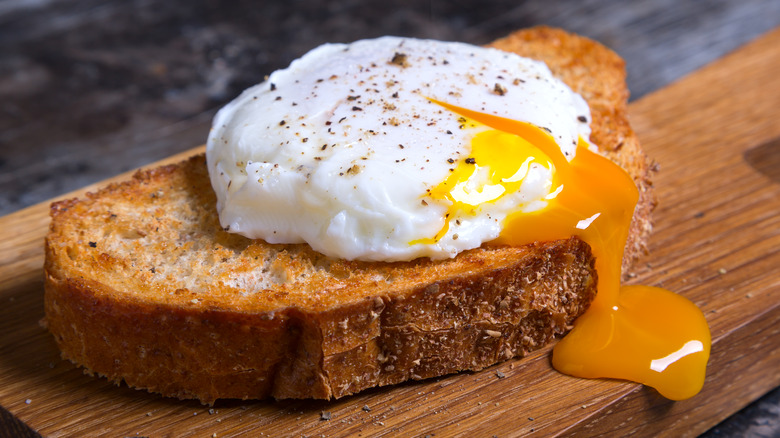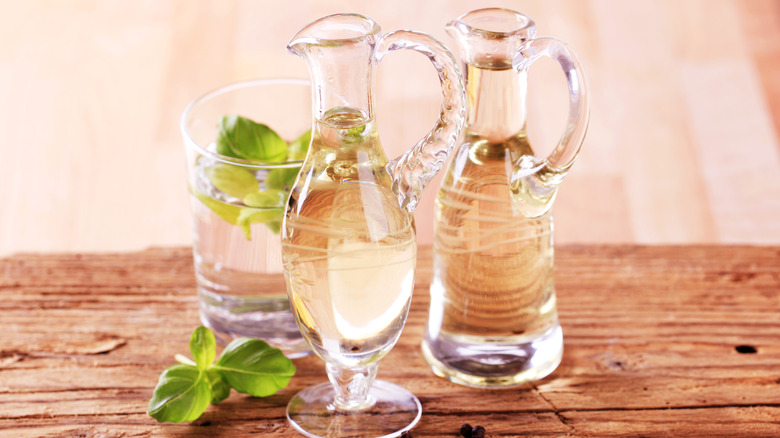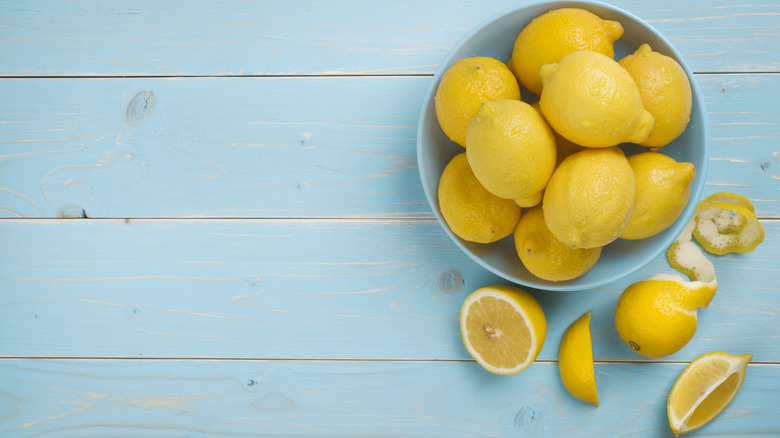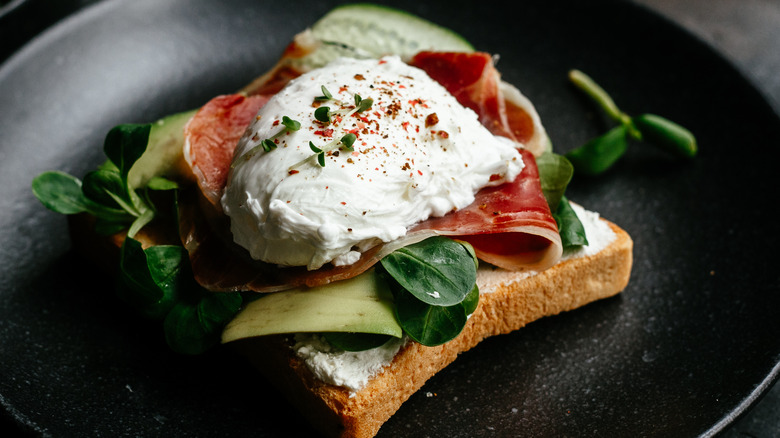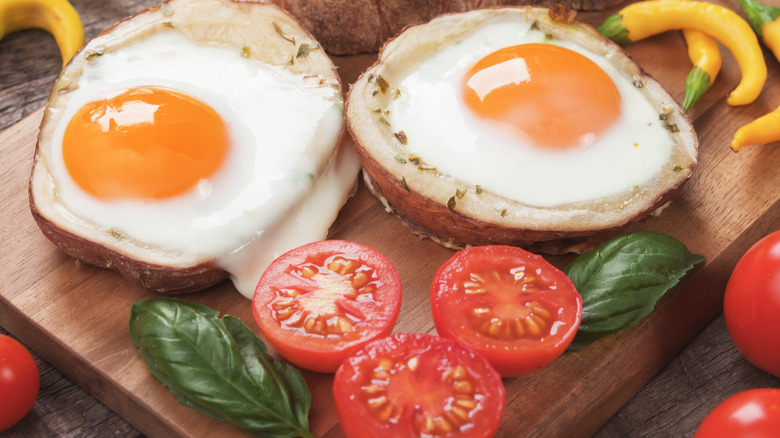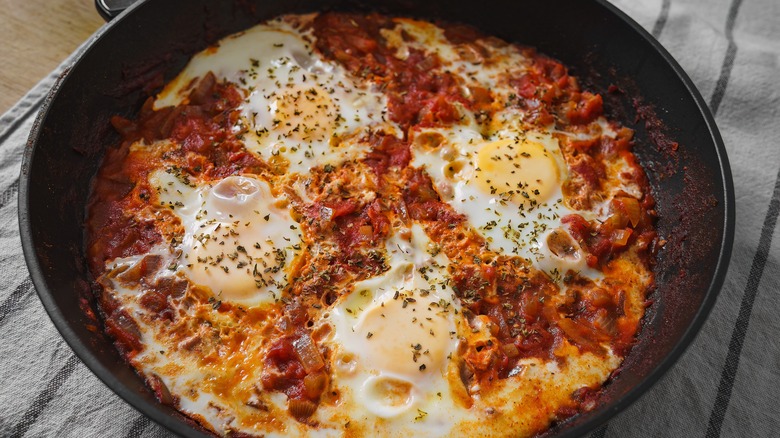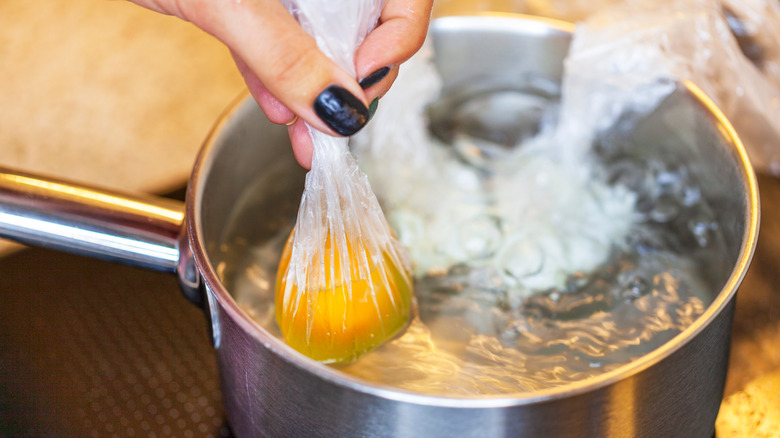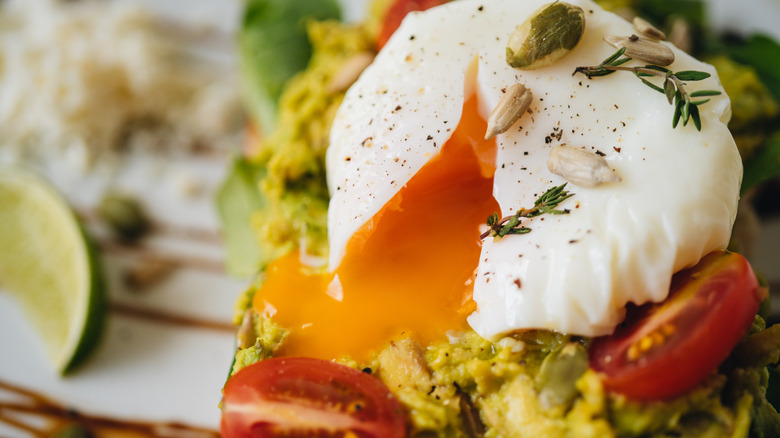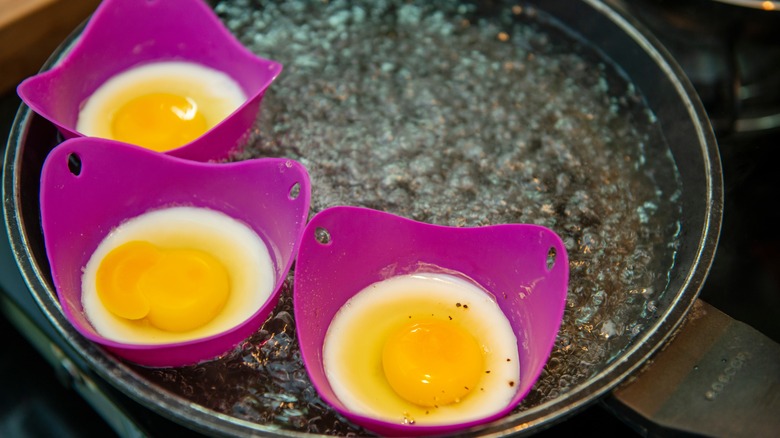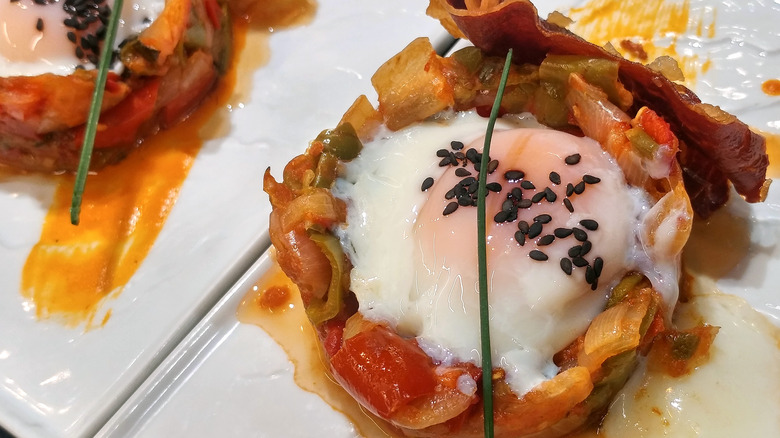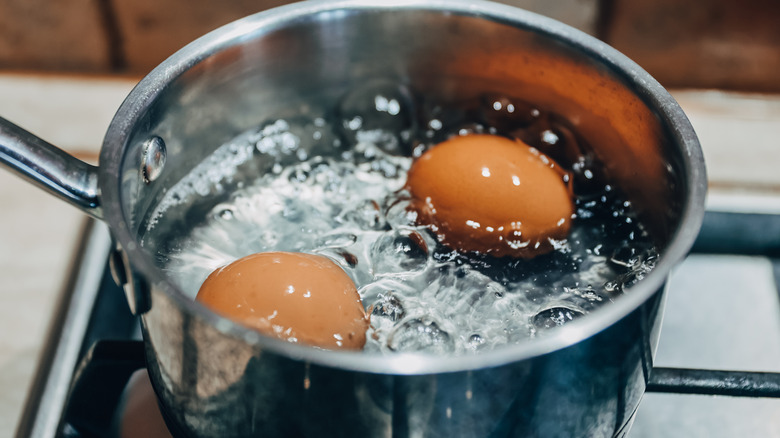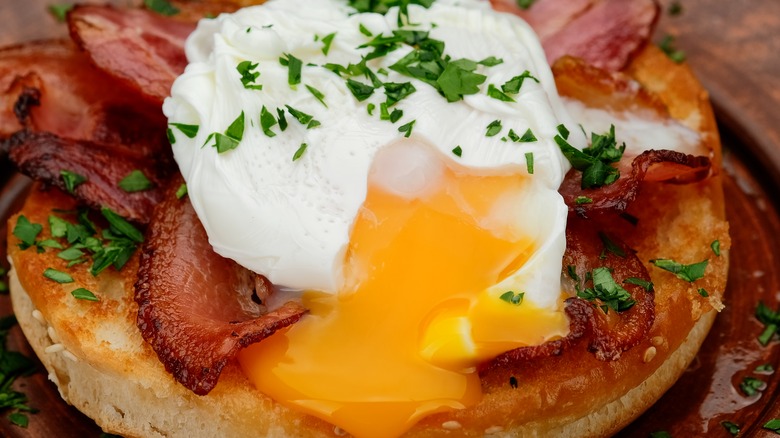11 Ways Celebrity Chefs Elevate Their Poached Eggs
Poached eggs are the undisputed star of many a brunch special, including eggs Benedict and pesto asparagus eggs. Made by simmering eggs in a pan of hot water, this treat offers a fabulous way to start your day. However, long before the rise of lazy Saturday mornings and bottomless mimosas, poached eggs were already considered a delicacy. In fact, members of the ancient Roman elite used to serve all types of eggs as appetizers at the beginning of their banquets. According to the ancient Roman cookbook, "De Re Coquinaria" by Marcus Gavius Apicius, poached eggs were among the specialties served (via Project Gutenberg). However, far from the modern toppings of hollandaise sauce and avocado, the meal was prepared with "pepper, lovage, soaked nuts, honey, vinegar, and broth."
Because this delicious meal has literally been popular for millennia, it's important to get the recipe right. Unfortunately, poached eggs are generally more difficult to make than your average scramble, and it's easy to accidentally serve them overcooked or poorly shaped. The good news is that modern celebrity chefs are full of tips that will help you make poached eggs that are both elegant on a platter and delicious to taste. From Curtis Stone to Jacques Pépin, these culinary professionals have shared their best tricks to elevate your eggs.
Curtis Stone: Add plenty of white wine vinegar
At first, vinegar might not sound like the most obvious substance to combine with poached eggs. However, that hasn't stopped celebrity chef Curtis Stone from integrating this ingredient into his recipe for poached eggs. As revealed in his appearance on "Coles" (via YouTube), the Michelin star winner uses white wine vinegar to ensure that his poached egg doesn't fall apart in the pan. He explained, "What you need is ... a big pot of boiling water ... then you take some white wine vinegar [and add it in]."
According to Stone, the reason that this substance works so well is that its composition will actually help your egg's texture. As the chef put it in his "Coles" video, "Now, the acidity from the vinegar is going to help the egg whites — the protein in the egg whites — coagulate. So, it's going to grab around the egg yolk. So, it's going to stay nice and tight together." To get the desired result, don't hesitate to add more than just a few drops of vinegar. Chef Stone recommends throwing in "two or three or even four tablespoons."
Interestingly, science backs the chef's method. Dr. Robert Keyzers of the School of Chemical and Physical Sciences at Victoria University of Wellington says that poaching eggs is all about chemistry. On the university's blog, the professor revealed that heat and acidic substances could harden the egg whites, solidifying their shape.
Nigella Lawson: Switch out vinegar for lemon
Curtis Stone's poaching method can work wonders when it comes to helping your eggs hold their shape. However, it is not the only celebrity chef trick that could elevate your poached eggs. If you don't have vinegar at home or just aren't a huge fan of the ingredient, look no further than Nigella Lawson for cooking tips. The TV chef has her own secret ingredient for making the perfect poach: lemons. Like vinegar, lemons have the high-acidity composition necessary to make your egg whites coagulate and hold their shape. Adding this simple ingredient to your poached eggs will ensure that they are smooth and firm rather than loose and lumpy.
While the Lawson method does engage with a lot of the same science as Stone's tips, the two styles of poaching differ considerably in terms of application. Instead of heating up a pot of water and adding an acidic substance to the mix, Lawson suggests adding lemons, or even vinegar, directly to the eggs themselves. As the celebrity chef instructed on her cooking blog, "[C]rack a fridge-cold egg — it holds its shape better if it's cold — into a cup and add a teaspoon of vinegar or lemon juice, and let it stand while a small pan of water comes to a boil." After the egg has plenty of contact with the lemon juice, Lawson suggests adding it slowly to the boiling water.
Emeril Lagasse: Feel the egg's firmness to know when it's done
Some of the world's best chefs develop their talents by getting their hands dirty, and Emeril Lagasse is no exception. The American celebrity chef says the best way to check whether your poached eggs are done is by touching them with your fingers. In a blog post on his official website, Lagasse recommended scooping your eggs out of the boiling water and poking them. "Test by lifting an egg slightly out of the water on a slotted spoon and gently pressing the center with your finger," the cookbook author instructed. Then, he says to check the consistency of both the egg whites and the yolk. "[T]he yolk should be soft, and the white [should be] firm," Lagasse explained.
Once you've prepared the perfect poached eggs, you can go ahead and serve them hot with a side of candied grilled bacon. Or, as chef Lagasse revealed, you can save your poached eggs in the fridge for later. If you are getting ready to throw a huge breakfast or brunch event, grab a bowl and fill it up with water. Place your poached eggs into the water and keep them in the refrigerator until it's time to serve them. Before plating your creation, Lagasse suggests throwing your poached eggs back on the stove. As he wrote on his blog, "Reheat by immersing briefly in simmering water."
Darren McGrady: Make your poached eggs into an egg Suzette
If you are searching for a poached egg technique that is good enough for royalty, look no further. Princess Diana's personal chef, Darren McGrady, had a surefire way to elevate his poached eggs — one that the late princess apparently found to be positively scrumptious. In an interview with Hello!, McGrady revealed that he used to add a few key ingredients to his poached eggs to turn them into an egg Suzette. As he told the British outlet, this meal comprised of "a baked potato scooped out with wilted spinach in the bottom and a poached egg on top and then a little hollandaise sauce, a tiny amount, with some potatoes piped around the edges."
To recreate one of Princess Diana's favorite breakfasts, you can start out by making the best baked potato recipe possible. Slice the final result in half, and rather than stuffing it with bacon and cheese, just remove a spoonful of potato flesh from each of the few sides. Be sure to carve out a wide space that your eggs can slip into easily. And, on a day that you are really in the mood to taste something worthy of palace life, make your own homemade hollandaise sauce to drizzle over your creation.
Jack Bishop: Cook the eggs in a sauce
For years, chef Jack Bishop of "America's Test Kitchen" hid a major secret. Even though he was technically a culinary professional, he was not keen on eating all types of poached eggs. In an interview with NPR, the TV chef opened up about his low-key anti-yolk past. "I'm 58. I'm a food professional my entire career. And until maybe eight or ten years ago, I never ate a runny egg ever," Bishop confessed. Given his career, this resistance to eating runnier poached eggs was less than ideal. The chef recalled, "You know, for me, it was becoming an embarrassing liability, right? I'm a professional ... And around me, there were people who were singing the praises of a gently poached egg. And I'm like, thanks, but no thanks, you know?"
Luckily, Bishop was eventually able to overcome his hesitance toward runny yolks, and these days, the celebrity chef recommends that other newbies try poaching their eggs in a sauce. One of the best ways to do this is by whipping up a hot pan of shakshuka, a North African meal in which eggs are poached in tomato sauce instead of water. According to Bishop, this plate is especially good for egg-hesitant people, as it will "give you more options beyond, you know, hard, hard, dry, overcooked eggs." To make this tasty vegetarian classic, add plenty of onions, tomatoes, and peppers to a skillet. Serve with a tomato and cucumber salad.
Jamie Oliver: Use plastic wrap to shape your eggs
At first glance, plastic wrap might not seem like it belongs anywhere near a recipe for poached eggs. Nonetheless, according to Jamie Oliver, this curveball kitchen tool can revolutionize your egg poaching skills. In a video posted to his website, the celebrity chef explained that wrapping your eggs in plastic wrap helps shape your final product. "So, I have a little technique. You get some food-safe cling film. Just get a little piece of it like that ... Crack in the egg ... What that's going to do is give you that perfect shape. That really guarantees perfection," Oliver shared.
To replicate Oliver's technique, start off by grabbing a small bowl. Place a sheet of Saran wrap over the bowl, add a dollop of olive oil, then crack the egg so that it falls inside the wrap. Afterward, you can twist the wrap closed over the top of the egg and drop it into your pot of simmering water. When you remove the egg from the pot, it should be smooth and round with minimal feathering.
The best part about this strategy is that you can use it to elevate the flavor and appearance of your poached eggs. As chef Oliver explained, you can even sprinkle some herbs inside the egg-filled wrap prior to cooking it. "The nice thing also is that you can ... put chopped herbs in. You can put harissa in."
Tom Kerridge: Cook your eggs slowly
TV chef Tom Kerridge might be known for winning a Michelin star, but he also knows how to enjoy the simpler things in life. Kerridge, who insists to Raconteur that he "isn't a Michelin-star kind of guy," is best known for earning a star for his pub-inspired establishment. And, in the spirit of delicious yet unpretentious home cooking, he has one easy tip for making poached eggs: Be patient. In an interview with Esquire, Kerridge was asked for tips on how to prepare the best fried, scrambled, or poached eggs. For all three types of eggs, the celebrity chef offered the same response. "Slow cooking," Kerridge answered. "It's all about not rushing the eggs otherwise they can become hard and rubbery."
Interestingly, science backs Kerridge's advice. Egg whites start to coagulate — or cook — when they heat up to about 145 degrees. However, for this to happen naturally, you can't just crank up the heat and hope that your eggs cook quickly. The reason that you can't just add tons of heat to your eggs actually pertains to their very composition. When eggs reach about 212 degrees, their protein molecules begin to squeeze water out from between them. This will ultimately leave them with a thick, rubbery texture. As a result, when it comes time to poach some eggs, resist the temptation to bring the water in your pot to a raging boil. Instead, settle on a slower-cooking simmer for better results.
Ina Garten: Use a sauté pan
Sometimes in the kitchen, using quality equipment makes all the difference. According to Ina Garten, this means poaching eggs in a sauté pan. In her view, this choice of equipment can save you the trouble of adding vinegar, lemon, or even Saran wrap to your creation. To make poached eggs à la "Barefoot Contessa", grab a large sauté pan, fill it halfway with water, and bring the water to a slow simmer. Then, instead of cracking out any fancy tricks, you should slide your eggs into the water, making sure to keep them spaced out. Whereas some of the other celebrity chefs suggest complex poaching solutions, Garten recommends simmering your eggs and then letting them sit.
If you are planning an elevated yet stress-free brunch, you might consider making poached eggs the "Barefoot Contessa" way. Serve your creation on a slice of sourdough with a bit of prosciutto or even some smoked salmon. For a side dish, make this colorful broccoli salad and serve it in a big bowl. Home cooks looking for a quick and easy dessert item might also consider finishing the meal with this 10-minute no-cook banana pudding.
Alton Brown: Make a whirlpool
If you have ever made poached eggs that look like they went through a shredder, then Alton Brown might have a technique to help you. On his official blog, the celebrity chef warns that eggs that don't stay whole during the poaching process are so common that there's even a name for it — feathering. To prevent feathering, Brown suggests creating a whirlpool in the center of your pan. With a spatula in hand, you can start making this fun current by drawing circles in the water of the pan. As you move your spatula, you should notice the water moving in one direction, forming a kind of spiral. When you are ready to add your eggs, slide them into the center of the whirlpool. This will help your eggs hold their shape as they cook.
While Brown's poaching tips are certainly compelling, it's important to keep in mind that no neat technique could ever offset the use of bad eggs. The celebrity chef warns against using eggs that aren't absolutely fresh, as this can impact the flavor of your overall product. When you have fresh eggs, you'll notice that there's a clear contrast between the egg whites and the yolks. You should also see that the yolk has a bit of curvature that sets it apart from the whites. Avoid eggs that are off-color, green, or iridescent, as these shades all signal that the ingredient should not be consumed.
Julia Child: Boil the eggs twice
Making twice-boiled poached eggs might sound complicated, but Julia Child makes it simple. The trick, according to the late celebrity chef, is to briefly simmer the whole egg before breaking the shell and poaching it. As Child explained in an episode of the PBS show, "Julia and Jacques Cooking at Home" (via YouTube), you can try this method with nothing more than an egg and a pushing pin. "So, I like to give the eggs a ten-second boil. And I first poke a hole in the large end [of the egg] with a little push pin because there is air in the large end, and that expands. And that could crack the egg," Child shared. The purpose of this initial boil is to help the poached eggs hold their shape, and as Child made extremely clear in the episode, you don't need to add vinegar or lemon to this recipe.
The second boil, meanwhile, is meant to actually poach the eggs. For this phase, Child recommends purchasing some special equipment to help you cook the eggs without having to rely on acidic ingredients or a whirlpool. "I'm going to use the oval perforated metal egg poacher," she revealed. Per the chef's explanation, this metallic device sits at the bottom of your pan under the boiling water. All you have to do is gently crack the egg so that its contents slip into the poacher and wait four minutes until it is done.
Jacques Pépin: Drag your eggs in the pan
While Julia Child enjoyed poaching her eggs with a metallic poacher and a push pin, Jacques Pépin often prepared his poached eggs with the help of a cooking spoon. After adding his eggs to vinegar-infused boiling water, Pépin recommends reaching for a perforated spoon and dragging the eggs through the water as they cook. As he shared in the PBS show "Julia and Jacques Cooking at Home" (via YouTube), "Now, what I'd like to do with my egg there is to drag it. Now drag the top like this ... And, if I drag the egg with the slotted spoon here, it moves [the egg] from the bottom." Apparently, this prevents the egg from making a mess on the bottom of the pan. "Otherwise, [your poached eggs] may stick a little bit," Pépin warned.
Interestingly, dragging your poached eggs around with a spoon isn't the only way to prevent them from sticking to the bottom of the pan. According to Pépin, one of the best things that you can do to prevent sticking is to boil your eggs in an ample amount of water. "You have to have enough water," Pépin advised. "We have about — what I would say — four inches of water."
